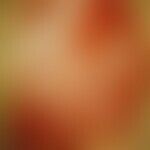Synonym(s)
HistoryThis section has been translated automatically.
The first report of EBA dates back to 1895, when Elliot (1895, later ROENIGK, 1971) described two adults with acquired skin fragility. Further cases of EBA were published in the following years. Due to similar clinical manifestations, EBA was initially described in 1895 as an adult-onset form of dystrophic epidermolysis bullosa (Nieboer C et al. 1980). In 1965, Pass et al. carried out histochemical studies from which they concluded that EBA pathogenesis was related to collagen changes. The first diagnostic criteria were not established until 1971 by Roenigk et al. The autoimmune character of EBA was demonstrated by the presence of IgG deposits in the basement membrane zone (BMZ) using direct immunofluorescence evaluation. The exact location of the immune complex deposits in the lamina densa was clarified by Yaoita et al. and Nieboer et al. using immuno-electron microscopy. In 1984, Woodley et al. identified a 290 kDa protein - collagen VII - as the target antigen in EBA (Hallel-Halevy D et al. 2001).
DefinitionThis section has been translated automatically.
Rare, acquired, blistering autoimmune disease with IgG (and IgA) antibodies against type VII collagen (NC1 domain), the main component of the "anchoring fibrils" in the dermoepidermal junction zone. The disease can occur after viral infections, as a paraneoplastic syndrome, also after autoimmunological reactions (e.g. after autologous stem cell transplantation).
You might also be interested in
ClassificationThis section has been translated automatically.
Two main subgroups can be distinguished on the basis of their clinical appearance:
- Epidermolysis bullosa acquisita, classic/mechanobullous (non-inflammatory) EBA
-
Epidermolysis bullosa acquisita, inflammatory (non-mechanobullous) EBA with the following variants:
- Epidermolysis bullosa acquisita, bullous pemphigoid-like EBA (47%) - tight blisters on erythematous or urticarial skin, mainly trunk and extremities
- Epidermolysis bullosa acquisita, mucous membrane pemphigoid-like EBA (7%) - lesions and scarring on the mucous membranes of the mouth, oesophagus, trachea and esophagus. oesophagus, trachea, conjunctiva
- Epidermolysis bullosa acquisita, scarring pemphigoid-like EBA (Brunsting-Perry type) (7%) - variant under the picture of a localized scarring pemphigoid
- Epidermolysis bullosa acquisita, linear IgAdermatosis-like EBA/IgA-EBA(3%) - variant under the picture of a linear IgA dermatosis of childhood.
Occurrence/EpidemiologyThis section has been translated automatically.
Incidence in Western Europe: 0.25-1.0/1.0 million inhabitants/year. No ethnic clustering.
EtiopathogenesisThis section has been translated automatically.
EBA is an autoimmune disease that belongs to the group of subepidermal bullous dermatoses. Its most important antigenic target is COLVII (collagen type 7-s.u. COL7A1 gene), which is located in the sublamina densa of the BMZ. COLVII, the main component of the anchoring fibrils, is a 290 kDa protein consisting of a central collagenous domain flanked by two non-collagenous domains, NC1 and NC2 (Kridin K et al. 2019). In patients with EBA, most autoantibodies target epitopes in the NC1 domain, although in a minority of cases, reactivity against the epitopes of the NC2 domains can be detected.
In general, these autoantibodies are of the IgG type. However, IgA, IgE and IgM antibodies have also been detected in some patients.
Sensitization of CD4 + T lymphocytes requires the presence of antigen-presenting cells (APCs) mediated by granulocyte-macrophage colony-stimulating factor (GM-CSF) and neutrophils. In addition to APCs, dendritic cells, macrophages and B lymphocytes are required for clonal expansion and plasma cell differentiation, with consecutive release of autoantibodies against COLVII (Koga H et al. 2018). The tissue lesions are triggered by the deposition of autoantibodies at the dermo-epidermal interface by binding to the COLVII epitope, which activates the complement system and releases pro-inflammatory cytokines. Neutrophils bind to the Fc domain of anti-COLVII22 autoantibodies and initiate a signaling cascade that includes activation of retinoid-related orphan receptor (ROR) alpha, heat shock protein HSP 90, phosphodiesterase 4 and phosphatidylinositol 4,5-bisphosphate 3-kinase (PI3K) (Koga H et al. 2018). Activated neutrophils express reactive oxygen species and proteases. These lead to damage and reduction of the anchoring fibrils with subsequent formation of blisters on the skin and mucous membranes (Kim JH et al. 2013).
The concordant occurrence with other autoimmune diseases, e.g. acquired hemophilia A, has been reported (Didona D et al.2024).
ManifestationThis section has been translated automatically.
Occurrence is possible at any age, usually between 40 and 60 years of age. Rarely occurring in children. m:w=1:1
ClinicThis section has been translated automatically.
Integument (short description):
- In the classic, mechano-bullous form of the disease, taut, non-inflammatory blisters of varying sizes are found. The main areas affected are the hands, elbows, feet, knees and, in rare cases, the oral mucosa. Occasionally, the affected areas heal with skin atrophy or milia, hyper- and hypopigmentation.
- In the non-classical inflammatory forms, diseases are described as bullous pemphigoid, localized scarring pemphigoid (Brunsting-Perry) or linear IgA dermatosis, with blistering of the face, sometimes also as impetigo contagiosa. Extracutaneous manifestations with the formation of oesophageal or urethral strictures are important. A connection between epidermolysis bullosa acquisita (EBA) and inflammatory bowel disease has been established in reviews. In 42 coincident cases, Crohn's disease (K50.9) was detected 35 times and ulcerative colitis (K51.9) 7 times. In most cases, the chronic inflammatory bowel disease preceded the skin changes (Reddy H et al. 2013). Note: The antigen of EBA (collagen type VII) is also expressed in the intestinal mucosa between the epithelium and stratum proprium.
HistologyThis section has been translated automatically.
See also under the variants of EBA.
Subepidermal blistering. Edema of the dermis. Bulky, diffusely arranged, predominantly neutrophilic infiltrates in the upper dermis, with gaping blood and lymph vessels. Diagnosis: Diffuse, superficial, predominantly neutrophilic dermatitis with subepidermal blistering.
Electron microscopy: cleft formation in the dermo-epidermal junction zone in the area of the sublamina densa zone. Reduction in the number of anchoring fibrils.
Direct ImmunofluorescenceThis section has been translated automatically.
Linear deposits of IgG and C3 at the BMZ are present in the perilesional skin in 93% of patients. These findings are not unique to EBA and can also be found in other subepidermal autoimmune bullous dermatoses (ABD). Fluorescence with anti-C3 is observed in 89% of cases, followed by anti-IgG in 79% of cases;45 IgA (47%) and IgM (21%) are observed less frequently. Exclusive IgA deposits are found in 2.4 % of cases, which correspond to IgA EBA (Iwata H et al. 2018). Analysis of the deposition pattern of the immune complex can increase the sensitivity of DIF . A u-jagged fluorescence pattern indicates the presence of autoantibodies bound to COLVII of the anchoring fibrils, while the n-jagged fluorescence pattern indicates the identification of antigens located over the lamina densa, such as BP180, p200, laminin 332 and laminin γ. The salt cleavage skin technique can be performed on the fragment obtained from the skin lesion and shows fluorescence on the skin side of the cleavage.
Immunoelectron microscopy: Detection of IgG, C3 and IgA deposits in the anchoring fibrils beneath the lamina densa by direct immunoelectron microscopy remains the gold standard method for the diagnosis of EBA. As this method is not available in most institutions, additional tests are recommended to confirm the diagnosis of EBA.
Immunohistochemistry: Formalin-fixed and paraffin-embedded fragments from the lesional skin of patients with EBA are stained with anti-collagen IV located in the lamina densa. Since the cleavage in EBA occurs below the lamina densa, collagen IV is positive on the upper surface of the blister.
Indirect immunofluorescenceThis section has been translated automatically.
In approximately 50-60% of patients, IgG and/or IgA autoantibodies against type VII collagen can be detected serologically. Detection is initially by indirect IF using salt-split skin as substrate. In EBA, the autoantibodies bind to the bottom of the artificial bladder. However, this is not conclusive for EBA, as p200 antigen and laminin-332 are also expressed at the bottom of the bladder.
ELISA (NC1/NC2) or immunochip (with cells expressing COL7) can be used to detect collagen 7-specific antibodies. Also possible is detection by Western blot on dermal extract with detection of a band at 290 kD.
DiagnosisThis section has been translated automatically.
Clinic and detection of a u-serrated pattern in direct IF confirm the diagnosis.
If the pattern does not present in the direct IF, the diagnosis can be made in the case of linear Ig/C3 deposits in the direct IF as follows:
- Serological detection of type VII collagen specific autoantibodies.
- Immunoelectron microscopy
Differential diagnosisThis section has been translated automatically.
Epidermolysis bullosa dystrophica (difficult to compare as larger disease group; detection of mutations in a collagen VII gene)
Bullous medicinal exanthema: medical history; blistering on the trunk, possibly mucous membranes, not on mechanically altered areas such as hands, elbows, feet, knees
Dermatitis herpetiformis: small burning blisters. IF: granular IgA deposits in the tips of the papillae.
Pemphigus vulgaris: detection of specific antibodies
Pemphigoid, bullous: detection of specific antibodies
Complication(s)(associated diseasesThis section has been translated automatically.
EBA-associated diseases: Several systemic diseases associated with EBA have been identified, including amyloidosis, thyroiditis, multiple endocrinopathy, rheumatoid arthritis, pulmonary fibrosis, chronic lymphocytic leukemia, thymoma and diabetes mellitus. However, most of these have only been described in isolated cases. The only indisputable link is between MSD and inflammatory bowel disease (IBD), in particular Crohn's disease (K50.9). This association is observed in about 25% of MSD patients in the US and is less common in other countries, probably due to the presence of type VII collagen in the BMZ of the colon wall. In most patients, IBD occurs before the onset of MSD (Reddy H et al. 2013).
TherapyThis section has been translated automatically.
External therapyThis section has been translated automatically.
Internal therapyThis section has been translated automatically.
Systemic therapy is indicated in cases of generalization or mucosal involvement. Only some patients (especially with a strong inflammatory component) respond well to monotherapy with systemic glucocorticoids, medium dosage (60-80 mg/day prednisone equivalent). Therefore, the combination of glucocorticoids with the following immunosuppressants is recommended:
- Azathioprine (e.g. Imurek) 1-2 mg/kg bw/day
- Cyclophosphamide (e.g. Endoxan) 50 mg/day
- DADPS (e.g. Dapsone Fatol) 100-150 mg/day
- Ciclosporin A (e.g. Sandimmun) 5-7 mg/kg bw/day
- Colchicine (e.g. Colchicine Dispert Drg.) 0.5-2 mg/day.
A therapy trial is also possible with high doses of vitamin E (e.g. Evit Kps.) 600-1200 mg/day. Complete healing has been described in individual cases with this therapy, but improvement only occurs over a long period of time.
Newer therapeutic approaches:
- IVIG: Immunoglobulins (e.g. pentaglobin) 5 ml/kg bw/day i.v. for 3-7 consecutive days should lead to better results in combination with e.g. prednisolone or ciclosporin A treatment. According to the literature, intravenous immunoglobulins only appear to have an initial therapeutic effect. Long-term improvements have not been described.
- Dupilumab is considered a safe therapeutic trial if immunosuppressive therapy is not tolerated or possible (Diehl R et al. (2024).
- Plasmapheresis can reduce the maintenance dose of glucocorticoids and immunosuppressants as an accompanying measure.
ProphylaxisThis section has been translated automatically.
Preventing new lesions includes educating patients about protecting the skin from additional trauma with soft clothing and non-sticky dressings, cleaning lesions appropriately with soap and water, avoiding foods that can cause additional damage to the oral mucosa when chewed and swallowed, such as hot drinks and acidic, rough/crunchy products.
Note(s)This section has been translated automatically.
In individual cases, the simultaneous occurrence of malignancies has been described (cervical carcinoma, multiple myeloma, pancreatic carcinoma, liver carcinoma).
Associations with other autoimmune diseases have frequently been described: autoimmune thyroiditis, systemic lupus erythematosus, Crohn's disease.
LiteratureThis section has been translated automatically.
- Bari B et al. (1996) Colchicine for epidermolysis bullosa acquisita. J Am Acad Dermatol 34: 781-784
- Bauer JW (1999) Ocular involvement in IgA-epidermolysis bullosa acquisita. Br J Dermatol 141: 887-892
- Busch JE et al (2007) Epidermolysis bullosa acquisita and pancreatic neuroendocrine carcinoma-coincidence or pathogenetic association. JDDG 10: 916-918
- Caldwell JB et al (1994) Epidermolysis bullosa acquisita - Efficacy of high dose intravenous immunoglobulins. J Am Acad Derm 31: 827-828
- Didona D et al. (2024) A patient with concomitant epidermolysis bullosa acquisita, acquired hemophilia and disseminated warts. J Dtsch Dermatol Ges 22:591-593.
- Diehl R et al. (2024) Dupilumab for the treatment of epidermolysis bullosa acquisita. JDDG 22: 1417-1419
- Elliot GT (1895) Two cases of epidermolysis bullosa. J Cutan Genitourinary Dis (Chicago) 13: 10-18
- Goebeler M, Zillikens D (2003) Blistering autoimmune diseases of childhood] Dermatologist 54: 14-24
- Hallel-Halevy D et al. (2001) Epidermolysis bullosa acquisita: update and review. Clin Dermatol 19: 712-718.
- Hertl M, Schuler G (2002) Bullous autoimmune dermatoses. 1: Classification. Dermatologist 53: 207-219
- Iwata H et al. (2018) Meta-analysis of the clinical and immunopathological characteristics and treatment outcomes in epidermolysis bullosa acquisita patients. Orphanet J Rare Dis 13: 153
- Jappe U et al. (2000) Epidermolysis bullosa acquisita with ultraviolet radiationsensitivity. Br J Dermatol 142: 517-520
- Kasperkiewicz M et al.(2016) Epidermolysis Bullosa Acquisita: From Pathophysiology to Novel Therapeutic Options. J Invest Dermatol 136:24-33.
- Kim JH et al (2013) Epidermolysis bullosa acquisita. J Eur Acad Dermatol Venereol 27: 1204-1213
- Koga H et al (2018) Epidermolysis bullosa acquisita: the 2019 update. Front Med 5 362
- Kridin K et al (2019) Epidermolysis bullosa acquisita: A comprehensive review. Autoimmune Rev 18: 786-795
- Ludwig RJ et al. (2017) Mechanisms of Autoantibody-Induced Pathology.Front Immunol 8:603.
- Mohr C et al. (1995) Successful treatment of epidermolysis bullosa acquisita using intravenous immunoglobulins. Br J Dermatol 132: 824-826
- Nieboer C et al (1980) Epidermolysis bullosa acquisita. Immunofluorescence, electron microscopic and immunoelectron microscopic studies in four patients Br J Dermatol 102: 383-392.
- Niederau D (1995) Epidermolysis bullosa acquisita - Successful treatment with dapsone in combination with glucocorticosteroids. Z Hautkr 70: 454-455
- Prost-Squarcioni C et al. (2018) International Bullous Diseases Group: consensus on diagnostic criteria for epidermolysis bullosa acquisita. Br J Dermatol 179: 30-41
- Reddy H et al. (2013) Epidermolysis bullosa acquisita and inflammatory bowel disease: a review of the literature. Clin Exp Dermatol 38:225-229; quiz 229-30.
- Roenigk HH et al. (1971) Epidermolysis bullosa acquisita: Reports of three cases and review of all published cases. Arch Dermatol 103: 1-10
- Schmidt E (2002) Childhood epidermolysis bullosa acquisita: a novel variant with reactivity to all three structural domains of type VII collagen. Br J Dermatol 147: 592-597
- Schmidt E et al (2013) Pemphigoid diseases. Lancet 381:320-332.
- Tanaka, N et al. (2009) A case of epidermolysis bullosa acquisita with clinical features of Brunsting-Perry pemphigoid showing an excellent response to colchicine. J Am Acad Dermatol 61: 715-719
- Trigo-Guzman FX et al (2003) Epidermolysis bullosa acquisita in childhood. J Dermatol 30: 226-229
- Vodegel RM (2003) Anti-epiligrin cicatricial pemphigoid and epidermolysis bullosa acquisita: differentiation by use of indirect immunofluorescence microscopy. J Am Acad Dermatol 48: 542-547
- Vodegel RM et al. (2002) IgA-mediated epidermolysis bullosa acquisita: two cases and review of the literature. J Am Acad Dermatol 47: 919-925
- Woodley DT et al. (1984) Identification of the skin basement-membrane autoantigen in epidermolysis bullosa acquisita. N Engl J Med 310: 1007-1013
Incoming links (14)
Acquired haemophilia A;; Autoimmune dermatoses, bullous; Bullosis diabeticorum; Bullous systemic lupus erythematosus; Cimicose; EBA Brunsting-Perry type; Epidermolysis bullosa acquisita, MM-EBA (7%); IgA-EBA; Linear IgA dermatosis; Pancreatic diseases and skin; ... Show allOutgoing links (39)
Acquired haemophilia A;; Adverse drug reactions of the skin; Atrophy of the skin (overview); Azathioprine; Bullous Pemphigoid ; Chronic lymphocytic thyroiditis; Ciclosporin a; COL7A1 Gene; Colchicine; Collagens; ... Show allDisclaimer
Please ask your physician for a reliable diagnosis. This website is only meant as a reference.
Images (7)
Articlecontent
- History
- Definition
- Classification
- Occurrence/Epidemiology
- Etiopathogenesis
- Manifestation
- Clinic
- Histology
- Direct Immunofluorescence
- Indirect immunofluorescence
- Diagnosis
- Differential diagnosis
- Complication(s)(associated diseases
- Therapy
- External therapy
- Internal therapy
- Prophylaxis
- Note(s)
- Literature
- References
- Authors











